A gray, fine-grained arkosic sandstone tablet bearing an inscription in ancient Hebrew from the First Temple Period contains a rich assemblage of particles accumulated in the covering patina. Two types of patina cover the tablet: a thin layer of black to orange iron-oxide-rich layer, a product of micro-biogenic processes, and a light beige patina that contains feldspars, carbonate, iron oxide, subangular quartz grains, carbon ash particles and gold globules (1 to 4 micrometers [1 micrometer = 0.001 millimeter] in diameter). The patina covers the rock surface as well as the engraved lettering grooves and blankets and thus post-dates the incised inscription as well as a crack that runs across the stone and several of the engraved letters. Radiocarbon analyses of the carbon particles in the patina yield a calibrated radiocarbon age of 2340 to 2150 Cal BP. The presence of microcolonial fungi and associated pitting in the patina indicates slow growth over many years. The occurrence of pure gold globules is evidence of a thermal event in close proximity to the tablet (above 1000 degrees Celsius). This study supports the antiquity of the patina, which in turn, strengthens the contention that the inscription is authentic.
By Amnon Rosenfeld
Geological Survey of Israel
By Shimon Ilani
Geological Survey of Israel
By Howard R. Feldman
The Anna Ruth and Mark Hasten School, A Division of Touro College
Division of Paleontology (Invertebrates), American Museum of Natural History
By Wolfgang E. Krumbein
Department of Geomicrobiology, ICBM, Carl von Ossietzky Universitaet, Oldenburg, Germany
By Yoel Kronfeld
Department of Geophysics and Planetary Sciences, Tel-Aviv University
November 2008
INTRODUCTION
Our team of scientists spent some time examining the Jehoash Inscription tablet (JI) from the point of view of hard science (Ilani et al., 2002; 2008). Our goal was to determine, based solely on scientific evidence, whether the tablet is a forgery or genuine. Since this tablet represents the only Judahite royal inscription found to date, it is of critical importance to history and Biblical Archaeology. The tablet is engraved with an inscription in ancient Hebrew that commemorates the renovation of the First Temple carried out by King Jehoash (9th century B.C.E. = 2800 years BP). A similar account of the Temple repairs is also found in Kings II: 12. According to Cohen (2007; 2008), the translation of the 16 lines of the ancient Hebrew is as follows:
I. Prologue (lines 1-4)
[I am Yeho'ash, son of
A]hazyahu, k[ing over Ju]dah,
and I executed the re[pai]rs.
II. Body of the inscription (lines 4-14)
When men's hearts became
replete with generosity in
the (densely populated) land and in the (sparsely
populated) steppe, and in all the cities of Judah, to
donate money for the sacred
contributions abundantly,
in order to purchase quarry
stone and juniper wood and
Edomite copper / copper from (the city of) ‘Adam,
(and) in order to perform
the work faithfully (=without corruption),—
(Then) I renovated the
breach(es) of the Temple
and of the surrounding
walls, and the storied structure,
and the meshwork, and the winding stairs,
and the recesses, and the doors.
III. Epilogue (lines 14-16)
May (this inscribed stone) become this day
a witness that the work has succeeded,
(and) may God (thus) ordain His people with a blessing.
Analyses of the tablet's epigraphy and philology to date have proven to be inconclusive as to its authenticity (Ilani et al., 2002; 2008). Chemical, geologic and petrographic analyses support the antiquity of the patina, which in turn, strengthens the contention that the inscription is authentic.
THE TABLET
The general color of the fine-grained JI tablet is gray to black (Ilani et al., 2002; 2008). A fissure, less than 0.5 millimeters (mm) in width, runs across the central part of the tablet parallel to the broken upper edge, crossing ten letters in four lines (Fig. 1). The crack fades inward toward the center of the tablet and is almost invisible on its back. The presence of the crack favors the authenticity of the inscription since a modern engraver would have known that incising across this line of weakness would have jeopardized the structural integrity of the tablet. The tablet broke into two separate pieces along this fissure after being taken into custodial care by the Israel Antiquity Authority (IAA). The sudden breakage of the tablet revealed that the top half of the fissure exhibits some natural bleaching and incipient patina formation due to weathering whereas the lower part of the tablet exhibits a clearly fresh line of breakage (Figs. 2 and 3).
Analysis shows that the rock tablet is composed mainly of very small unsorted subangular quartz grains and angular to subrounded, unsorted feldspar grains. When we studied the rock in thin section (slices about 0.03mm in thickness) we found that it is composed of the following minerals: quartz (35%), feldspars (55%), epidote (3%), chlorite (1%), rutile and sphene (<1%), iron oxides and opaques (2-5%). This type of sandstone occurs in Cambrian formations found in southern Israel and in southwest Jordan (Bender, 1968) and was therefore available to ancient stone workers in Judea. Such local rocks are found south of the Dead Sea, in the Timna area and in southern Sinai, mainly in the Amudei Shelomo, Timna and Shechoret formations (Weissbrod, 1987). In the Temple of Serabit el-Khadem in southern Sinai, hundreds of stelae with hieroglyphic inscriptions from the Middle and New Kingdoms are carved from the arkosic sandstone of the Shechoret Formation (upper part). These rocks are the same type of which the JI tablet is made of. However, Goren et al. (2004) classify the type of rock as a "graywacke." In geology, rock type often has implications as to the provenance of the basin of deposition in which the rock was formed. Such a definition led them to note that such metamorphic rocks are not reported from outcrops in the southern Levant. Thus, aspersion was cast on the authenticity of the artifact. However, their identification of the rock was erroneous. Thin section analysis of the Yehoash tablet examined also by the petrographer Dr. Arieh Shimron, Geological Survey of Israel, confirmed our original definition (Ilani et al., 2002) of arkosic sandstone.
Many of the incised letters exhibit defects in shape at their edges. These defects are due to the detachment of quartz and feldspar grains during the erosion and weathering of the sandstone.
THE PATINA
The patina is the outer crust that was formed due to chemical and biological conditions resulting from weathering of the rock and the material interacted and accreted from its burial environment. The patina on the side of the inscription is composed of two layers (Figs. 4 and 5). The first thin layer, up to 1 mm thick, is attached firmly to the rock. This film-like black to reddish-brown iron oxide, covers the surfaces of the tablet and the letters. As the rock tablet contains about 5% iron oxides, we believe that the formation of this film may be related to natural geobiological weathering processes. A second layer, lighter in color, beige to ochre and up to 1 mm thick, is found mostly within the letters but also on the surface that was partly cleaned. This light patina covers also the fractures and the middle crack (Fig. 1; Ilani et al., 2002, Fig.3; Ilani et al., 2008, Fig. 1b). It contains silica, feldspar and carbonate minerals that form a texture of interlocking grains supported by carbonate matrix that contains small carbon ash particles (Ilani et al., 2002, Fig. 5). Some pure gold globules of 1-4 micrometers in diameter were also detected (Ilani et al., 2002, Fig. 6). The patina obviously was formed naturally because the tablet was buried for an extensive period within a tel or soil environment. We can exclude a cave as the site of deposition. The patina on the surface carrying the inscription is composed of elements derived from the tablet itself (e.g., quartz and feldspar grains) as well as from the environment (dolomite, limestone, carbon ash particles, and gold globules). The patina on the back of the tablet has the same composition but with some silica and carbonate in one place (about 2.5 cm in diameter) near the top of the tablet. This siliceous-carbonate material could be an original vein filling within a bedding plane or a joint in the original rock, similar to those found in the clastic rocks exposed in southern Israel and Sinai, and may represent a natural rock fissure along which the rock was detached for further processing as is the case in many quarries. Thus, the remnants of a vein were thought to be the "real" patina by Goren et al., (2004). The fact that it does not appear on the inscription surface was proof that the inscription was forged.
Moreover, Goren et al., (2004) suggest that the patina on the inscribed face of the tablet is too soft to be regarded as genuine. However, we propose that the softness or hardness of the patina cannot be used as an indicator of authenticity, especially as we reported that the light patina had been exposed to cleaning. But the biogenic black-reddish patina with the pitting made by microorganisms is firmly connected to the stone (Figs. 2-3).
The suggestion by Goren et al., (2004, p. 14) that "heated water was used to harden and ensure good adhesion of the patina" seems to us unfounded.
After production and the engraving of the JI inscription, the tablet underwent significant changes by burial processes, especially by cleaning and enhancement after excavation. The surface of the JI, as well as the letters, is covered by continuous black-reddish and beige patina layers (Figs. 4-6). No indications of adhesive materials or other artificial substances that could indicate addition, pasting, or dispersion of artificial patina on the inscribed face of the tablet have been observed.
AGE OF THE PATINA
Carbon ash particles are trapped within the patina. Samples of the patina were radiocarbon dated at an age of 2340 to 2150 years ago (Ilani et. al., 2008; t\Table 2).
GOLD GLOBULES
The gold globules that we detected are minute, usually 1 to 2 micrometers in diameter and were found in 4 of the 9 samples taken from the patina (Ilani et al., 2002, Fig. 6). The gold is in the form of individual globules of well sorted size (1-4 micrometers). The distribution of the globules detected by a scanning electron microscope (SEM) is approximately 10 globules per square mm and the total weight of the globules in the patina was calculated to be to less than 0.001 g for the entire tablet.
MICROCOLONIAL FUNGI
Microcolonial Fungi (MCF) are known to concentrate and deposit manganese and iron and play a key role in the alteration and biological weathering of rocks and minerals. They are microorganisms of high survivability, inhabiting rocks in extreme conditions and are also known to survive in subsurface and subaerial environments. We found long-living black yeast-like fungi that form pitted embedded circular structures of 20-500 micrometers in size on the patina (inside the letters [Fig. 4] as well Ilani et al., 2008, Figs. 9,10). A Nabbatean flint instrument from Avdat, southern Israel, 2,000 years old, shows an identical MCF black red-brown coloration and pitted circular structures as in the JI tablet. These fungal colonies (identified as Coniosporium sp. and related species) grow very slowly over dozens to hundreds of years.
DISCUSSION
We found a rich assemblage of different particles within the patina of the JI tablet that contains feldspars, carbonate, iron oxide, subangular quartz grains, carbon ash particles and gold globules (1 to 4 micrometers in diameter). Goren et al., (2004) claimed that gold globules were incorporated into the patina by a forger. Gold powder comprised of globules 1-2 micrometers in diameter does not exist in the modern gold market as suggested by them. Gold globules in today's market are of a wide range and mix of sizes, the smallest diameter being 500 micrometers. However, gold powder or dust, with an average size between 70 to 80 micrometers, has an angular shape. Native gold dust from Sardis, Turkey contains irregular flattened flakes with rounded edges, 100-500 micrometers in size, but not globules. According to Meeks (2000), pure gold globules of 3-300 micrometers in diameter were found in the production and refining site of Sardis resulting from melting processes. One would expect many gold globules of various sizes to occur in clustered aggregates in the patina if it were of recent origin, but this is clearly not the case. The small amounts detected and its distribution would be difficult to produce within any artificial patina. The occurrence of pure gold globules (1-2 micrometers) is evidence of the melting of gold artifacts or gold-gilded items (above 1000 degrees Celsius).
Exposures of Cretaceous marine carbonate rocks are abundant in Jerusalem and provide a majority of its building stone. Indeed, well preserved marine carbonate microfossils that were found within the patina were derived from the weathering of these exposed rocks as well as by wind transport. These minute fossils occur in abundance in everyday dust in Jerusalem (Ehrenberg, 1860; Ganor, 1975) as well as in the local soils. But, Goren et al., (2004) claimed that their finding of foraminifera (microfossils) within the patina of the engraved surface of the JI tablet is a proof of a fake patina. We maintain that these microfossils within the patina can be easily explained as a component of a genuine patina derived from the surrounding Cretaceous marine carbonate rocks that are ubiquitous in the Judean Mountains. Indeed, their absence within a patina purportedly coming from the Jerusalem area would be suspicious since the entire city is situated upon these marine rock exposures. These microfossils should be as plentiful in the historical past as they are today. We therefore strongly disagree that these microfossils are an indication of forgery.
Goren et al, (2004) claimed that the engraved marks of the letters are fresh. They said that signs of fresh cuttings and polishing are exposed within the letters. Fresh engraving can be easily revealed by illuminating the tablet with ultraviolet light (Newman, 1990). However, when the tablet was illuminated with ultraviolet light, there was no characteristic fluorescence indicative of fresh engraving scars. In addition, the biogenic black to reddish patina is covering and firmly attached to the letters with morphological continuity to the tablet surface (Figs. 2, 3 and 6).
Based upon the results of four oxygen isotopic analyses of the carbonate patina, Goren et al., (2004) concluded that the tablet must be a fake. Yet, of the four samples only two can be related to carbonate precipitation from fresh water. The two enriched ("heavy") delta O18 (capital O is the chemistry symbol of oxygen; delta O18 is the measured ratio of the O18/O16 isotopes of the oxygen) values (-1.7 per thousand and –0.9 per thousand PDB) of the patina carbonate presented by Goren et al. (2004) can be attributed to the predominance of a marine carbonate component (upon which Jerusalem sits and its building stone is made). The conclusion that the patina must be a fake is thus drawn upon the basis of the only two depleted delta O18 patina analyses which they compared to the delta O18 values preserved in dated stalagmite caves in the Jerusalem area (Goren et al., 2004, p. 7 and Fig. 9). They concluded that the delta O18 values of the carbonate patina are too depleted to have been derived from natural meteoric water of the region and therefore claimed evidence of fraud. However, there are ways that isotopically depleted carbonate can be generated and incorporated into a genuine patina. One example is a thermal event. It has recently been brought to our attention that an isotopic study of white crusts that cover limestones that had been burned during the destruction of the Second Temple at 70 C.E. show depleted delta O18 PDB values (-10.7 per thousand -13.4 per thousand) (Dr. A. Shimron, personal communication, 2004). Therefore such isotopic depleted carbonate values are found in the Jerusalem area.
Lately, the compositions of oxygen isotopes were measured in patinas on several artifacts from officially sanctioned excavations, and they exhibit a wide range of values (Professor Aldo Shemesh, Weitzman Institute, personal communication). The values of the oxygen isotopes not only vary between different geographic locations but vary also in the same location as well as in the same artifact. Discrepancies from stalagmite deposition range up to delta O18 -8 per thousand PDB. It is clear that the use of the oxygen isotope method for the authentication of archaeological artifacts is premature and unreliable. To our knowledge, this method is not used in any lab in the world today.
The formation of a patina on archaeological artifacts is probably produced in a series of sporadic events and is not comparable to continuous growth of stalagmite rings. Thus, it is inaccurate to assume that patina formation is comparable to the formation of stalagmites in a closed system ignoring all interactions with the environment, the microorganisms as well as anthropogenic interventions.
A SCENARIO FOR THE TABLET'S ORIGIN AND FORMATION
The following scenario may place the tablet's stages of development into a historical context. The inscription resembles the Biblical description of repairs of the Temple in Jerusalem by Yehoash, King of Judah, son of Ahaziyahu (Kings II, 12:1-6, 11-17) and the letters "haziyahu" and "Judah" appear in the inscription. Thus the tablet may be a royal inscription that was placed in Jerusalem at the time of King Yehoash, about 2800 years BP. If this scenario is correct, then both the nature of the patina and the fact that its apparent age is younger than the inscription by 500 years needs to be explained. We propose the following sequence of events.
The tablet may have been emplaced in Jerusalem about 2800 years BP and remained there for about 200 years, during which time the margins of its letters were weathered. When the Temple was destroyed by the Babylonians about 2600 years BP (586 B.C.E.), the tablet was broken and subsequently buried in the rubble. After burial, the patina began to accrete on the tablet including carbon fragments. We believe that the apparent age of 2,250 years BP as determined in the laboratory is an average of several pieces of soot (carbon), both younger and older than that age.
The presence of the pure gold globules can also be explained within this scenario since gold is not a constituent of the rock tablet nor found within any of the sedimentary rocks in the Jerusalem area. The source of the gold globules may have been gold artifacts or gold-gilded items that existed in Jerusalem at that time. As Jerusalem was burned (Kings II 25, 9), some of the gold could have melted in the conflagration, been injected into the air and re-solidified there, to settle later as minute globules on the ground. These globules were later incorporated within the patina that developed on the buried tablet.
We believe that the tablet underwent seven stages of formation:
-
A stonecutter carved a tablet from local sandstone.
-
The letters were incised.
-
Weathering processes caused the detachment of quartz grains along the margins of the letters.
-
The tablet was fractured on two sides and cracked in the center.
-
A thermal event occurred in which gold was heated to a temperature of more than 1000 degrees Celsius and melted forming gold globules.
-
These globules were sorted and winnowed into the soil near where the tablet was deposited.
-
The globules as well as carbon ash from the conflagration were trapped within the patina. Simultaneously, micro-bio-geological processes were responsible for the development of this patina.
CONCLUSIONS
Our analyses altogether support the authenticity of the JI tablet and tablet inscription. All evidence hints to a joint or very close age origin of the production of the tablet and the incised inscription. In summary:
1. The central crack and the upper fracture cut across several lines and letters,
2. The margins of the letters are weathered,
3. Quartz and feldspar grains found within the patina are identical to those found within the rock,
4. The patina that covers the tablet includes carbon ash particles and minute and well-sorted globules of pure gold, a product of melting,
5. The surface pattern inside several cleaned letters is similar to the surface pattern of the tablet showing morphological continuity,
6. The age of the charcoal interlocked within the patina is approximately 2,250 years BP according to carbon dating,
7. We did not find any element related to the use of modern tools,
8. The microbiogenic patina is dense, coating all surfaces as well as the engraved letters, and indicates growth over extended periods of time. Pitting, due to the slow growth of MCF, falls within the time frame of the First Temple Period and,
9. The use of the oxygen isotope method for the authentication of archaeological artifacts is premature and unreliable. To our knowledge this method is not used in any lab in the world today.
REFERENCES
Bender, F. (1968). Geologie Von Jordanien-Beitraege Zur Regionalen Geologie der Erde (Volume 7). Berlin: Gebrueder Borntraeger Berlin.
Cohen, C. ( 2007). Biblical Hebrew Philology in the light of research on the new yeho'ash Royal Building Inscription. in New Seals and Inscriptions: Hebrew, Idumean, and Cuneiform, Ed. by Meir Lubetski (Hebrew Bible Monographs, 8), Sheffield: Sheffield Phoenix Press, pp. 1-69.
Cohen, C. (2008). Biblical Hebrew Philology in the light of research on the new yeho'ash Royal Building Inscription. Annual Meeting of the European Association of Biblical Studies 2008 (August 3-6), Lisbon, University of Lisbon.
Ehrenberg, C. G. (1860). Über einen sehr merkwürdigen Meteorstaubfall in Jerusalem mit großem Orkan am 8-9. Februar d, Jahres, Monatsberichte der KöniglichenPreussischen Akademie der Wissenschaften zu Berlin, 121, 137-151.
Ganor, E. (1975). Atmospheric dust in Israel: sedimentological and meteorological analysis of dust deposition. Unpublished doctoral dissertation, Hebrew University, Jerusalem.
Goren, Y., Ayalon, A., Bar-Matthews, M. & Schilman, B. (2004). Authenticity examination of Jehoash inscription. Tel Aviv, 31, 3-16.
Ilani, S., Rosenfeld, A. & Dvorachek, M. (2002). Archaeometry of a stone tablet with Hebrew inscription referring to repair of the House. Israel Geological Survey Current Research, 13, 109-116.
Ilani,S., Rosenfeld, A., Feldman, H.R., Krumbein, W.E., & Kronfeld, J. (2008). Archaeometric analysis of the Jehoash Inscription tablet. Journal of Archaeological Science, 35, 2966-2972.
Meeks, N.D. (2000). "Scanning electron microscopy of the refractory remains and the gold." In A. Ramage & P. Craddock (Eds.), Examination of the Sardis gold and the replication experiments (pp. 99-156). Monograph Volume 11. Cambridge: British Museum.
Newman, R. (1990). Weathering layers and the authentification of marble objects. In M. True & J. Podany (Eds.), Art historical and scientific perspectives on ancient sculpture (pp. 263-282). The Journal of the Paul Getty Museum. Malibu: California.
Weissbrod, T. (1987). The Paleozoic of Sinai and the Negev. In G. Gvirtzman, A. Gradus, Y. Beit-Arie & M. Har-El (Eds.), Sinai physical geography (pp. 43 -58). Tel Aviv: Ministry of Defense.
EXPLANATIONS OF FIGURES
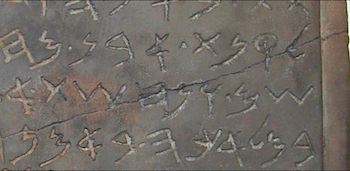
Figure 1. The "Jehoash Inscription" tablet composed of arkosic sandstone with an ancient First Temple Period Hebrew inscription. Note the detail of the tablet showing part of the right side of the prominent central fissure (now broken) transecting the engraved letters. The patina is covering the letters as well as the fissure (the width of the right-hand margin is approximately 15 mm).
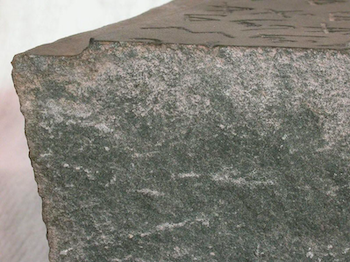
Figure. 2. A view of the lower part of the broken tablet along the fissure in Figure 1 (line 8 of the right side including its lower margin). The "shin" from the 9th line can be seen in the upper part. The sandstone is medium gray whereas the patina of the fissure (1/3 of its width) is light gray. A thin black, orange-brown biogenic patina layer attached firmly to the rock covers all surfaces of the tablet as well as the grooves of the letters (the black and brown-patina is 1 mm thick).
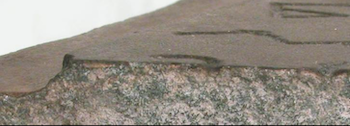
Figure 3. Enlargement of Figure 2. Note the broken part of the lower part of the "lamed" and the lower part of the "kuf." The thin patina composed of biogenic iron oxide is attached firmly to the rock surface and covers the grooves of the letters (the black and brown-patina is 1 mm thick).
![Figure 4. Note the biogenic pitting and black to brown patina formation within the letter "heh" [inverted] caused by black yeast-like fungi on the sandstone of the JI tablet. The patina layers consist of a lower biogenic iron oxide black to brown film above which is a light beige-ochre upper layer (the width of the engraved grooves of the letter is about 1 mm).](/sites/bibleinterp.arizona.edu/files/content/images/arxh%204.png) Figure 4. Note the biogenic pitting and black to brown patina formation within the letter "heh" [inverted] caused by black yeast-like fungi on the sandstone of the JI tablet. The patina layers consist of a lower biogenic iron oxide black to brown film above which is a light beige-ochre upper layer (the width of the engraved grooves of the letter is about 1 mm).
Figure 4. Note the biogenic pitting and black to brown patina formation within the letter "heh" [inverted] caused by black yeast-like fungi on the sandstone of the JI tablet. The patina layers consist of a lower biogenic iron oxide black to brown film above which is a light beige-ochre upper layer (the width of the engraved grooves of the letter is about 1 mm).
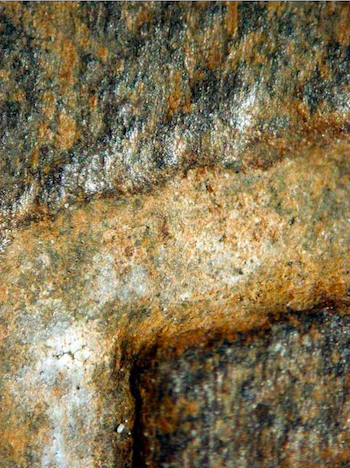 Figure 5. Observe a groove representing a part of a letter and the layers of the patina that fill in and cover the letter as well as the rock surface. The lower patina layer consists of black and orange-brown layers occurring one next to the other. Both are composed of iron-oxide that can be seen on lateral margins of the groove as well as on the surface of the tablet, above which is a light beige-ochre upper patina layer (the width of the groove is about 1 mm).
Figure 5. Observe a groove representing a part of a letter and the layers of the patina that fill in and cover the letter as well as the rock surface. The lower patina layer consists of black and orange-brown layers occurring one next to the other. Both are composed of iron-oxide that can be seen on lateral margins of the groove as well as on the surface of the tablet, above which is a light beige-ochre upper patina layer (the width of the groove is about 1 mm).
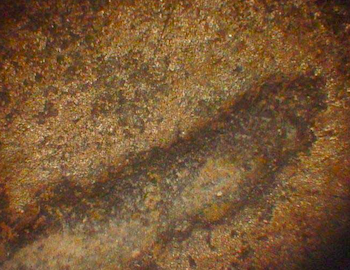 Figure 6. Biogenic black to brown patina formation within the letter "tav" caused by black yeast-like fungi on the JI tablet. Note the morphological continuity between the patina on the rock surface and the engraved rock. This iron oxide patina is the product of microcolonial fungi activity during a long period of time (the width of the groove of the letter is about 1 mm).
Figure 6. Biogenic black to brown patina formation within the letter "tav" caused by black yeast-like fungi on the JI tablet. Note the morphological continuity between the patina on the rock surface and the engraved rock. This iron oxide patina is the product of microcolonial fungi activity during a long period of time (the width of the groove of the letter is about 1 mm).
Comments (1)
A layman's comments:
The detailed notes argue well for the authenticity of the Jehoash Tablet. Nevertheless, forgers are clever. (I believe it is a fact that a number of forged paintings hang in famous museums, the detection of which sometimes gets into the news.)
The photographs available to the layman on the internet and in the Press are somewhat small. Nevertheless, it strikes me that, if one compares two or more examples of the same letter, they appear to be identical in form. This would suggest that they were carved using a stencil or template. I assume that stencils were not used by ancient engravers. Therefore, if it could be shown that stencils were used in the engraving of the Jehoash Tablet, it would indicate forgery.
Some of the letters do not fall into this pattern; the forger (if there was one) realised that not every example of a given letter should look identical.
Has such a test been used to test the authenticity of the Jehoash Tablet?
Gerald Myers
#1 - Gerald Myers - 10/19/2013 - 09:34
